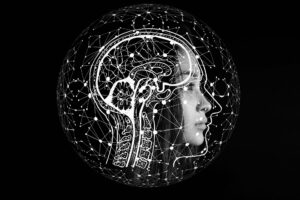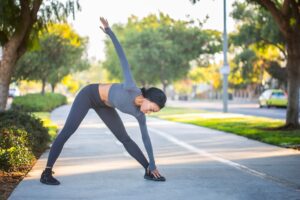It is interesting to study the link between the practice of physical activity and the maintenance of cognitive functions. It is observed that the more we advance in our life, the more our cognitive functions are likely to decline. But people who engage in regular physical activity and activities involving cognitive effort (puzzles, crossword puzzles, memory challenges, doing two things at the same time), maintain these cognitive functions better with age. The body and the brain work as a team.
It has been observed especially that seniors who practice regular aerobic activity, that is to say an activity that makes them a little breathless, reduce the risk of cognitive decline by almost 20% in the next six years. In addition, practicing activities requiring a cognitive challenge on a daily basis would reduce the risk of developing Alzheimer’s disease by five. (Casaletto et al., 2020)
The brain, an essential and complex organ
The brain is an essential organ for our body. It is made up of different regions which each have a role to play. Messages from the brain are transmitted to the part of the body concerned thanks to its incredible nervous network made up of billions of fibers. Its functions are multiple.
The brain controls:
– muscles
– tissues
– the organs of the body
– movements
– the senses
– the more automatic functions of the body such as respiratory rate, blood flow or even body temperature.
The brain is also essential in managing emotions, memory, and social behavior, among others.

Cognitive functions, different facets of human thinking
Cognitive functions are essential in everyday life. They are led by the brain. They encompass everything related to knowledge and in particular allow us to communicate, learn and perceive our environment.
Cognitive functions include many areas:
– attention: be aware of your environment, be able to concentrate on one task, or even several simultaneous tasks.
– memory: it can be retrospective (past event, memory of my grandmother’s cakes), prospective (future event, don’t forget to buy bread at home), procedural (I remember very well how change the tire of a car!), the semantics (the date of Columbus’ discovery of America escapes me …), or even working memory, that is to say to process and manipulate data for use when writing the phone number).
– language: oral or written, it breaks down into several stages. Formulate the message and send it, or receive and interpret it.
– visuospatial functions: they make it possible to adequately perceive objects in space, to find their bearings, to orient themselves, to evaluate distances for example.
– processing speed: among all these messages that go to the brain, each mental operation is initiated, then executed at a certain rate. I see an object fall, I tell my brain to reach out to grab it, and the operation is started and performed so quickly that I could catch it before it hits the ground. Or on the contrary, I have the impression that between the moment when I ask my body to walk andwhen I finally manage to take the first step, there is a lot of time…
– executive functions: they make it possible to plan (an effective strategy to carry out an action), to inhibit (resist distractions), to be mentally flexible (by adapting to changes), to judge (by evaluating the best alternative in a given context), and finally to give meaning to self-criticism (thus being able to assess one’s capacities, behaviors and difficulties).
Physical activity simply nourishes the brain
The brain feeds on sugar, oxygen and nutrients, which are supplied by the blood. Blood irrigates and maintains neural networks. When you move, there is more blood flow to the brain. It is therefore better fed. A well-fed brain is a better functioning brain.
Physical activity can even influence the volume of certain areas of the brain (Meng, Lin, & Tzeng, 2020). Each area of the brain has a specific role. The hippocampus, for example, plays an important role in memory, inhibition, and visual-spatial functions. A larger hippocampus will be more efficient at accomplishing the cognitive tasks for which it is responsible.
Moving keeps the body in good condition, especially the brain!

Choosing the ideal physical activity for maintaining cognitive functions
The practice of physical activity is a wide field. There are many different ways to train, depending on the goal. Duration and intensity are important factors to consider. One study followed women for 8 years who reported their daily walking periods. Women who walked at least 1.5 km per day were 15% less likely to decline cognitively. (Yaffe, Barnes, Nevitt, Lui, & Covinsky, 2001).
Another study looked at the effects of aerobic physical activity on neurological disorders, and in particular Alzheimer’s disease (Barnes, 2015). Aerobic physical activity is defined as the use of oxygen to create energy, going beyond the energy stocks that we have in reserve. These are therefore activities of longer duration, but of moderate intensity, possibly weak. The results of the study suggest that the benefits of aerobic physical activity on Alzheimer’s disease are linked to the redistribution of rich blood flow in the brain, as well as to the activity of neurons in brain regions usually less stressed and affected by Alzheimer’s disease.
Finally, some scientists were interested in the effect of resistance and balance training on cognitive functions (Eckardt, Braun, & Kibele, 2020). One of the research groups trained in resistance, on training equipment, and the other group also trained in resistance, but without load on unstable surfaces (squats on Bosu, lunges on blocks of foam). After training two days a week for 10 weeks, they re-passed the tests performed at the start of the study, assessing: working memory, processing speed, response inhibition and cognitive flexibility. The group that trained in unstable resistance improved significantly in the first 3 tests, unlike the stable resistance group. This type of physical activity influences the nervous system at different levels, such as neuroplasticity and neurotrophins.
All these studies confirm that it is important to train your body and your brain by choosing an appropriate physical activity. Whether it’s resistance training or aerobic physical activity, there will be benefits for your brain. Ideally, you should bet on a combination of these different training methods and above all, make it a daily habit!
Barnes, J. N. (2015). Exercise, cognitive function, and aging. Advances in Physiology Education, 39(2), 55-62. doi:10.1152/advan.00101.2014
Casaletto, K. B., Rentería, M. A., Pa, J., Tom, S. E., Harrati, A., Armstrong, N. M., . . . Zahodne, L. B. (2020). Late-Life Physical and Cognitive Activities Independently Contribute to Brain and Cognitive Resilience. J Alzheimers Dis, 74(1), 363-376. doi:10.3233/jad-191114
Eckardt, N., Braun, C., & Kibele, A. (2020). Instability Resistance Training improves Working Memory, Processing Speed and Response Inhibition in Healthy Older Adults: A Double-Blinded Randomised Controlled Trial. Scientific Reports, 10(1), 2506. doi:10.1038/s41598-020-59105-0
Meng, Q., Lin, M. S., & Tzeng, I. S. (2020). Relationship Between Exercise and Alzheimer’s Disease: A Narrative Literature Review. Front Neurosci, 14, 131. doi:10.3389/fnins.2020.00131
Yaffe, K., Barnes, D., Nevitt, M., Lui, L.-Y., & Covinsky, K. (2001). A Prospective Study of Physical Activity and Cognitive Decline in Elderly Women: Women Who Walk. Archives of Internal Medicine, 161(14), 1703-1708. doi:10.1001/archinte.161.14.1703







Comments